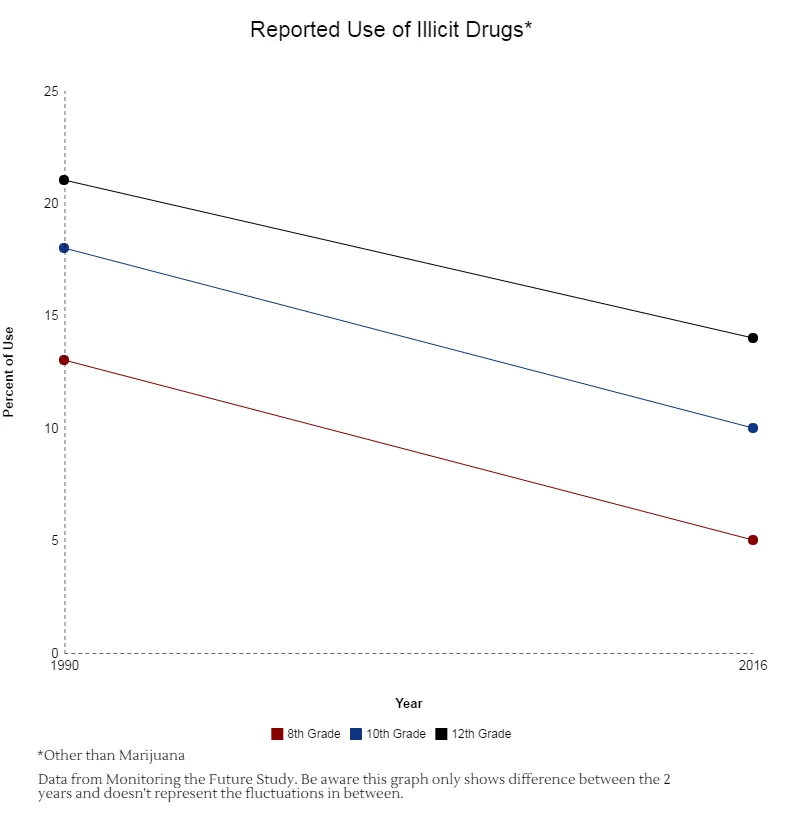There is no shortage of drug and alcohol prevention in the United States. But is there a shortage of programs that actually work? From the time President Reagan claimed drugs to be a threat to the United States, to the moment President Nixon declared a “war on drugs,” to present-day awareness of the growing epidemic, hundreds of programs have been created in hopes of keeping young people from becoming addicted to drugs or alcohol.
Some programs focus on recovery, while others hope to stop youth from becoming involved with drugs or alcohol in the first place. Although every program starts with the best intentions, some fall flat, while others have a positive impact on the entire community. The most recent reported usage trends are looking optimistic. Unfortunately, it can be a challenge for communities, schools, or even parents to determine which tactics are working.
The annual Monitoring the Future study recently found drug use to be lower in 2016 than it has been since the 1990s. While this is wonderful news, it’s difficult to understand what variable may be causing the downward trend. Is it further education, different prevention programs, better parenting, or another cause?

Different Tactics to Prevent Drug and Alcohol Abuse
While we may not be able to identify the exact turning point in an adolescent’s mind when they decide not to use drugs or alcohol, the National Institute on Drug Abuse has identified 16 principles for a prevention program to be successful. A program needs to be supported from multiple angles, not just through schools. Typically, when families and communities are both behind the program and talking with their youth, there is more possibility for success.

Research shows there are different kinds of discussions and tactics that work best depending on the maturity of the child. It makes sense for parents to begin these conversations while the child is young, and to continue to have them. KidsHealth.org gives advice for talking to your kids in preschool and how to advance the conversation as they grow up. Pact 360 reports that kids who learn about the risks of substance abuse at home are significantly less likely to use.
“Talking to my children about drugs and alcohol wasn’t easy at the beginning, but definitely worth it in the long run to keep them safe,” says Brian Collins, an Oklahoma City parent. “Our school’s drug awareness program really helped open the discussion and guide the direction of my advice for them.”
Current Drug and Alcohol Prevention Programs Being Used in the United States
There are many different drug and alcohol prevention programs being used today by parents, schools, and communities. Here is a sampling of available programs with downloadable resources to help make the conversation easier, as well as information on how to bring a program to your community.
International/ National Programs
D.A.R.E.
D.A.R.E, Drug Abuse Resistance Education, was founded in 1983 by the Los Angeles Police Department. D.A.R.E. has evolved since its creation and focuses on elementary and middle-school students’ decisions, not drugs. The D.A.R.E. program is taught in all 50 states, as well as in 52 other countries. If you are a parent or caregiver interested in bringing D.A.R.E. to your community, gather with like-minded people and approach your child’s school about incorporating the program.
Foundation for a Drug-Free World
This non-profit corporation educates youth and adults about drugs. This corporation has distributed 50 million drug prevention booklets worldwide. They have created a downloadable Educator’s Guide complete with lesson plans and instructions for teaching.

Community-Focused Programs
Parents 360
Parents 360 is a community program designed to educate adults and parents about drug use and how to have an open dialogue. There are guides and training materials you can use to learn how to bring the program to your schools.
Too Smart To Start
This public initiative was created to inform families, educators and community leaders, along with young people, on drug and alcohol and its effects. There are lesson plans and resources for educators to use. It also has tips for how the general public and community leaders can help by building media relations and getting people to talk about the issue.
We encourage everyone to get involved in one of the many efforts to educate the youth about drug and alcohol addiction before it’s too late. It’s not just the parents’ responsibility; it’s the schools, churches, older sisters and brothers, and communities’ job to open the dialogue and be a resource. We offer free speaking engagements and would love to come talk to your school or group about drug and alcohol addiction. Contact us today.
